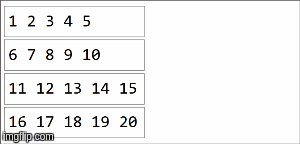reduceByKey: How does it work internally?
ScalaApache SparkRddScala Problem Overview
I am new to Spark and Scala. I was confused about the way reduceByKey function works in Spark. Suppose we have the following code:
val lines = sc.textFile("data.txt")
val pairs = lines.map(s => (s, 1))
val counts = pairs.reduceByKey((a, b) => a + b)
The map function is clear: s is the key and it points to the line from data.txt and 1 is the value.
However, I didn't get how the reduceByKey works internally? Does "a" points to the key? Alternatively, does "a" point to "s"? Then what does represent a + b? how are they filled?
Scala Solutions
Solution 1 - Scala
Let's break it down to discrete methods and types. That usually exposes the intricacies for new devs:
pairs.reduceByKey((a, b) => a + b)
becomes
pairs.reduceByKey((a: Int, b: Int) => a + b)
and renaming the variables makes it a little more explicit
pairs.reduceByKey((accumulatedValue: Int, currentValue: Int) => accumulatedValue + currentValue)
So, we can now see that we are simply taking an accumulated value for the given key and summing it with the next value of that key. NOW, let's break it further so we can understand the key part. So, let's visualize the method more like this:
pairs.reduce((accumulatedValue: List[(String, Int)], currentValue: (String, Int)) => {
//Turn the accumulated value into a true key->value mapping
val accumAsMap = accumulatedValue.toMap
//Try to get the key's current value if we've already encountered it
accumAsMap.get(currentValue._1) match {
//If we have encountered it, then add the new value to the existing value and overwrite the old
case Some(value : Int) => (accumAsMap + (currentValue._1 -> (value + currentValue._2))).toList
//If we have NOT encountered it, then simply add it to the list
case None => currentValue :: accumulatedValue
}
})
So, you can see that the reduceByKey takes the boilerplate of finding the key and tracking it so that you don't have to worry about managing that part.
Deeper, truer if you want
All that being said, that is a simplified version of what happens as there are some optimizations that are done here. This operation is associative, so the spark engine will perform these reductions locally first (often termed map-side reduce) and then once again at the driver. This saves network traffic; instead of sending all the data and performing the operation, it can reduce it as small as it can and then send that reduction over the wire.
Solution 2 - Scala
One requirement for the reduceByKey function is that is must be associative. To build some intuition on how reduceByKey works, let's first see how an associative associative function helps us in a parallel computation:

As we can see, we can break an original collection in pieces and by applying the associative function, we can accumulate a total. The sequential case is trivial, we are used to it: 1+2+3+4+5+6+7+8+9+10.
Associativity lets us use that same function in sequence and in parallel. reduceByKey uses that property to compute a result out of an RDD, which is a distributed collection consisting of partitions.
Consider the following example:
// collection of the form ("key",1),("key,2),...,("key",20) split among 4 partitions
val rdd =sparkContext.parallelize(( (1 to 20).map(x=>("key",x))), 4)
rdd.reduceByKey(_ + _)
rdd.collect()
> Array[(String, Int)] = Array((key,210))
In spark, data is distributed into partitions. For the next illustration, (4) partitions are to the left, enclosed in thin lines. First, we apply the function locally to each partition, sequentially in the partition, but we run all 4 partitions in parallel. Then, the result of each local computation are aggregated by applying the same function again and finally come to a result.

reduceByKey is an specialization of aggregateByKey aggregateByKey takes 2 functions: one that is applied to each partition (sequentially) and one that is applied among the results of each partition (in parallel). reduceByKey uses the same associative function on both cases: to do a sequential computing on each partition and then combine those results in a final result as we have illustrated here.
Solution 3 - Scala
In your example of
val counts = pairs.reduceByKey((a,b) => a+b)
a and b are both Int accumulators for _2 of the tuples in pairs. reduceKey will take two tuples with the same value s and use their _2 values as a and b, producing a new Tuple[String,Int]. This operation is repeated until there is only one tuple for each key s.
Unlike non-Spark (or, really, non-parallel) reduceByKey where the first element is always the accumulator and the second a value, reduceByKey operates in a distributed fashion, i.e. each node will reduce it's set of tuples into a collection of uniquely-keyed tuples and then reduce the tuples from multiple nodes until there is a final uniquely-keyed set of tuples. This means as the results from nodes are reduced, a and b represent already reduced accumulators.
Solution 4 - Scala
Spark RDD reduceByKey function merges the values for each key using an associative reduce function.
The reduceByKey function works only on the RDDs and this is a transformation operation that means it is lazily evaluated. And an associative function is passed as a parameter, which is applied to source RDD and creates a new RDD as a result.
So in your example, rdd pairs has a set of multiple paired elements like (s1,1), (s2,1) etc. And reduceByKey accepts a function (accumulator, n) => (accumulator + n), which initialise the accumulator variable to default value 0 and adds up the element for each key and return the result rdd counts having the total counts paired with key.